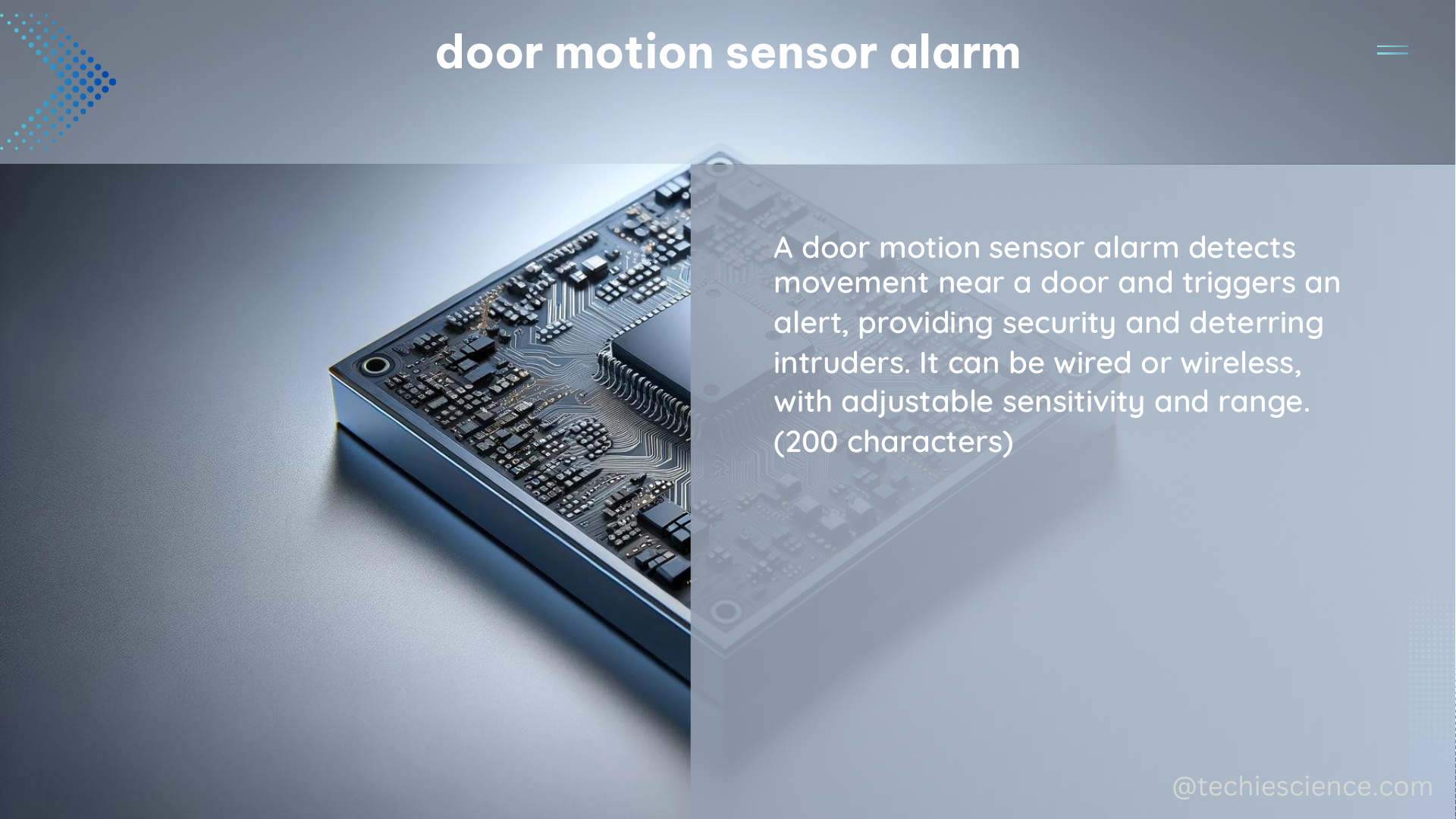A door motion sensor alarm is a sophisticated security system designed to detect unauthorized entry or motion near a door, providing a critical layer of protection for homes, businesses, and other sensitive areas. This comprehensive guide delves into the technical specifications, installation best practices, and maintenance requirements to ensure optimal performance of your door motion sensor alarm system.
Understanding the Anatomy of a Door Motion Sensor Alarm
A door motion sensor alarm typically consists of three key components:
-
Sensor: The sensor is the heart of the system, responsible for detecting motion or changes in the door’s position. These sensors can utilize various technologies, such as passive infrared (PIR), microwave, or dual-technology (PIR and microwave) to enhance detection accuracy.
-
Alarm Indicator: The alarm indicator is the component that generates the auditory or visual alert when the sensor detects an intrusion. This can range from a simple siren to more sophisticated systems that integrate with smart home devices or security monitoring services.
-
Alarm Assessment System: The alarm assessment system verifies and evaluates the alarm alert, often through the use of closed-circuit television (CCTV) or human monitoring. This ensures that the alarm is a genuine threat and not a false trigger, reducing unnecessary response.
Technical Specifications: Ensuring Optimal Performance

To ensure your door motion sensor alarm system operates at its peak efficiency, it’s crucial to understand the technical specifications that govern its performance. Let’s dive into the key data points:
Data Communication Subsystem
The data communication subsystem is responsible for transmitting alarm data in a timely manner. According to industry standards, alarms should be communicated to the alarm station operator within 2 seconds of sensor activation. This rapid response time is essential for a swift and effective security response.
BMS Operational Test
The Building Management System (BMS) operational test involves verifying the sensor’s functionality by opening the door and confirming that an alarm is received at the designated location. The sensor should then return to a secure state and remain so even when the door is closed, latched, and pushed back and forth.
Maintenance Requirements
Proper maintenance is crucial for ensuring the long-term reliability of your door motion sensor alarm system. Industry guidelines recommend performing maintenance checks every 6 months, including:
- Verification of tamper operation: Ensuring the sensor can detect and report any attempts to tamper with the system.
- Alarm response to foreign magnetic field: Confirming the sensor can detect and generate an alarm when a foreign magnetic field is introduced, which could indicate an attempted bypass.
- Verification of electrical power and communication line conditions: Ensuring the system’s power supply and communication lines are in acceptable condition.
Interior Microwave Sensors
Some door motion sensor alarm systems utilize interior microwave sensors, which emit an energy field and detect changes in the microwave energy caused by motion within the protected area. These sensors typically operate in the X-band radiofrequency region (7 to 11 gigahertz) and generate an alarm if the frequency difference exceeds a preset threshold.
DIY Installation: A Step-by-Step Guide
For those interested in a DIY approach to installing a door motion sensor alarm, it’s essential to follow the manufacturer’s instructions carefully and ensure proper installation. This process may include:
-
Verifying Installation Drawings: Ensure the sensor’s installation matches the provided installation drawings to ensure optimal coverage and functionality.
-
Preliminary System Riser Diagram: Create a preliminary system riser diagram to map out the sensor’s placement, alarm indicator, and any other connected components.
-
Detail Drawings: Include detailed drawings to showcase the sensor’s wiring and installation, providing a clear roadmap for the setup process.
-
Sensor Placement: Position the sensor in a strategic location that maximizes coverage and minimizes the risk of false triggers. Factors such as door size, traffic patterns, and potential obstructions should be considered.
-
Wiring and Connections: Carefully follow the manufacturer’s instructions for wiring the sensor to the alarm indicator and any other system components. Ensure all connections are secure and properly grounded.
-
System Testing: Conduct a comprehensive system test to verify the sensor’s functionality, alarm response, and integration with the overall security setup.
By adhering to these best practices, you can ensure your DIY door motion sensor alarm installation meets industry standards and provides reliable, long-lasting protection.
Conclusion
A door motion sensor alarm is a powerful tool in the arsenal of home and business security. By understanding the technical specifications, installation requirements, and maintenance protocols, you can ensure your door motion sensor alarm system operates at its peak efficiency, providing a robust layer of protection against unauthorized entry. This comprehensive guide has equipped you with the knowledge and resources to take on a DIY door motion sensor alarm project with confidence.
References:
- National Academy of Engineering. (2012). Security 101: A Physical Security Primer for Engineers and Technologists. National Academies Press.
- U.S. Nuclear Regulatory Commission. (2011). Intrusion Detection Systems and Subsystems. NUREG-1959.
- U.S. Army Engineering and Support Center. (2020). HNC Design Manual. PR-ED-2000.10.

The lambdageeks.com Core SME Team is a group of experienced subject matter experts from diverse scientific and technical fields including Physics, Chemistry, Technology,Electronics & Electrical Engineering, Automotive, Mechanical Engineering. Our team collaborates to create high-quality, well-researched articles on a wide range of science and technology topics for the lambdageeks.com website.
All Our Senior SME are having more than 7 Years of experience in the respective fields . They are either Working Industry Professionals or assocaited With different Universities. Refer Our Authors Page to get to know About our Core SMEs.